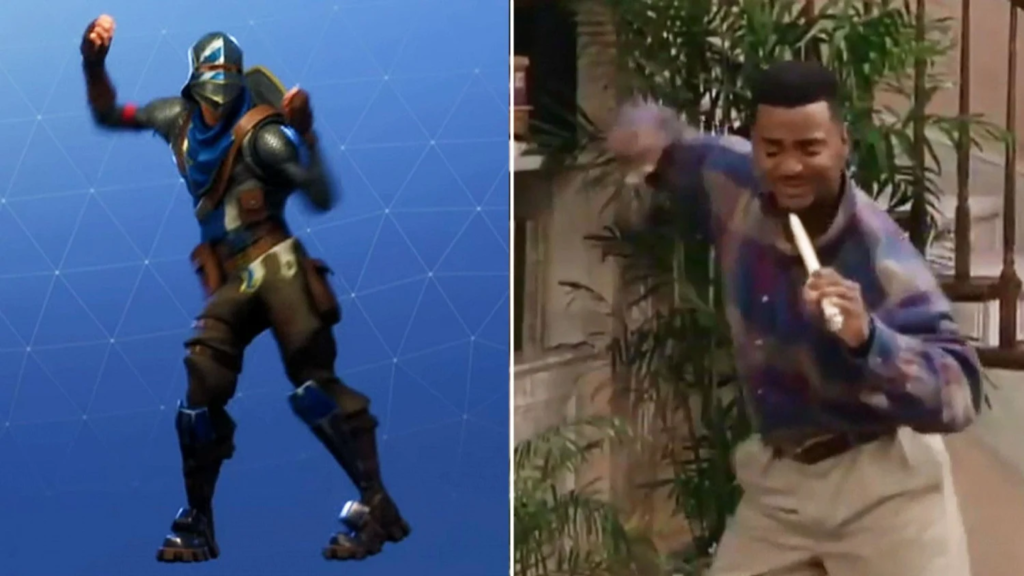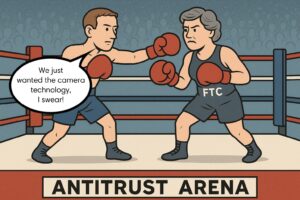In July 2017, Epic Games (“Epic”) released Fortnite and arguably revolutionized the video game industry. Fortnite’s release coincided with the height of the esports boom (the bubble has arguably burst – but that is a conversation for another time), as venture capital started pouring into the esports industry and social media networks like TikTok and Twitch started to gain mainstream popularity. Some of the biggest draws of Fortnite are its cartoon figures and the ability of characters to perform “emotes” – special dances or movements that are either free or available for purchase via the game’s item shop. One of the more popular emotes that was almost immediately available for purchase after Fortnite’s release was the “Fresh” emote, which was essentially a copy of Alfonso Ribeiro’s “Carlton” dance (the “Carlton”) from his time playing Carlton on the popular 90’s sitcom Fresh Prince of Bel Air.
Understandably, Ribeiro was frustrated that Epic was capitalizing on a dance that he felt he invented and made popular, so in December 2018, Ribeiro sued Epic for using the Carlton without his permission while simultaneously applying for the dance’s copyright registration. Unfortunately for Ribeiro, the US Copyright Office (the “Office”) denied his application, resulting in Ribeiro withdrawing his lawsuit against Epic. This blog will examine the US copyright laws pertaining to choreography, the US Copyright Office’s reasons for denying Ribeiro’s claim, and implications for content creators who may be seeking copyright protections for their original dances.
Copyrighting Choreography Generally
The Copyright Act,1 the statute that governs copyrights in the US, allows for certain choreographic works (the “Work”) to be protected by copyright.2 The Office defines choreography as the “composition and arrangement of a related series of dance movement and patterns organized in a coherent whole”.3 To be eligible for copyright registration, the Work needs to:
Include one or more of the following elements:4
Rhythmic movements of one or more dancers’ bodies in a defined sequence and a defined spatial environment, such as a stage;
A series of dance movements or patterns organized into an integrated, coherent, and expressive compositional whole;
A story, theme, or abstract composition conveyed through movement;
Presentation before an audience;
Executed by skilled performers;
Musical or textual accompaniment; and,
Be fixed in a tangible medium to be performed in a consistent and uniform manner, such as a dance notation, video recordings, textual descriptions, photographs, or drawings.5
Additionally, certain categories of dances and movements are expressly prevented from receiving registrations under the Copyright Act, such as:6
Individual movements or dance steps such as the basic waltz, hustle step, or the second position in classical ballet;
Short or simple dance routines that only consist of a few movements or steps, even if a routine is novel or distinctive;
Social dances (dances that are intended to be performed by members of the public for a participatory, social experience, such as ballroom dances, folk dances, square dances, swing dances, etc); and,
Athletic movements such as yoga poses or a touchdown celebration dance.
The Letter
On January 22, 2019, Ribeiro’s counsel received a letter from the Office7 which outlined the reasons that the Carlton was refused copyright registration. The letter ultimately outlined that the Carlton was a simple routine that could be broken down into 3 basic steps as follows:
The dancer sways their hips as they step from side to side while swinging their arms in an exaggerated manner;
The dancer takes two steps to each side while opening and closing their legs and arms in unison; and
The dancer’s feet are still and they lower the one hand from over their hand to the middle of their chest while fluttering their fingers.
In addition to being deemed as a simple routine, the fact that non-professional dancers can easily perform the Carlton in social settings (such as when I performed it with my brother in unison at a wedding this past weekend), the Carlton can arguably be viewed as being a social dance as well.
Shortly after Ribeiro received the letter, the United States Supreme Court affirmed that a copyright infringement lawsuit cannot commence unless a work has been registered by the Office, despite the fact an application may have been filed and in the process of consideration (except in limited circumstances such as when an author is preparing to distribute the work like a movie or musical composition).8 Accordingly, Ribeiro’s counsel withdrew the infringement claim against Epic since his Copyright registration for the Carlton was denied. The Fresh emote has not been available for purchase in Fortnite since November 2018.9
Implications
Although the Carlton was denied copyright registration in accordance with US Copyright laws, I don’t find this situation to be entirely fair. It’s quite clear that one reason Epic created the “Fresh” emote was to appeal to players who were fans of Fresh Prince of Bel Air. All you have to do is look at the name of the emote to recognize that Epic did not do the greatest job in trying to hide its intent. Perhaps Epic’s intellectual property lawyers suspected that despite the similarities with the Fresh emote and the Carlton, Ribeiro was going to have a hard time arguing to the Office that the Carlton was more than a simple dance routine. In addition to Ribeiro’s case, there are at least two other cases where individuals claimed Fortnite emotes were based on dance moves that they popularized (the “Running Man” and “Phone It In” emotes), both resulting in dismissals from the courts for similar reasons.10
On a positive note for content creators, Keara Wilson, inventor of the “Savage Challenge” dance, was able to obtain copyright registration for the dance routine she created.11 We were not able to locate a copy of the application’s description, however, we suspect some arguments that were made include that the routine involves more than just a few steps and it was published to TikTok before other individuals performed the dance in the same sequence, thereby proving Wilson’s authorship. Fortnite of course had also created a “Savage” emote,12 but since Wilson obtained copyright registration after the emote was already in the game, we wouldn’t be surprised if Wilson and Epic entered into some sort of licensing arrangement to keep the emote available for purchase in Fortnite’s item shop.
The results of the aforementioned suits are disappointing particularly because of the popularity of short-form video content. Even if a content creator popularizes or invents a simple dance move that goes viral, it seems that at least for now, US copyright law would not prevent game developers like Epic from incorporating such dance moves into their games, unless the content creator has successfully obtained copyright registration. It will be interesting to follow if/how US copyright laws evolve since the work of content creators and social media was not considered when copyright laws were originally developed. Content creators and agencies should be wary of commencing lawsuits for such claims unless they know for certain they have legal ownership of the intellectual property at issue. If you or your agency would like to talk about any intellectual property issues your company, agency, or content creators are dealing with, please don’t hesitate to contact us at GME Law.
1 The Copyright Act, 17 U.S.C. §§ 101-810 (the “Act”).
2 The Act at § 102.
3 Circular 52, Copyright Registration of Choreography and Pantomime, U.S. Copyright Office, October 2022 at page 1 (“Circular 52”).
4 Ibid.
5 Ibid.
6 Compendium of U.S. Copyright Office Practices (Third Edition), United States Copyright Office, January 2021, at 805.5 (the “Compendium).
7 United States Copyright Office Letter to Pierce Bainbridge Beck Price & Hecht LLP, re: The Dance by Alfonso Ribeiro, January 22, 2019.
8 Fourth Estate Public Benefit Corp v Wall Street.Com LLC, 586 U.S. ____ (2019) at page 3.
9 ProGameGuides.Com, Fortnite Fresh Emote.
10 See Pellegrino v Epic Games Inc, 451 F. Supp 3d 373 re: the “Phone It In” emote; See Brantley v Epic Games Inc, 463 F. Supp 3d 616 re: the “Running Man” emote.
11 U.S. Copyright Office Public Records System, Registration record PA0002243519, “Savage Challenge”.
12 ProGameGuides.Com, Fortnite Savage Emote.




